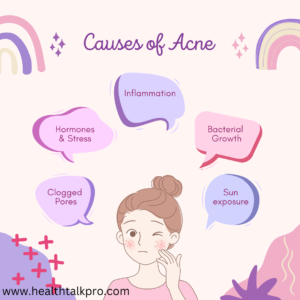Acne is a common skin condition that affects millions of people worldwide. It can be frustrating, embarrassing, and even painful. But what exactly is acne, and how can you prevent and treat it? In this article, we’ll delve into the causes, symptoms, prevention, diagnosis, and treatment options of acne, so you can take control of your skin and say goodbye to those pesky pimples.
What is Acne?
Acne is a skin condition characterized by the occurrence of comedones (blackheads and whiteheads), papules, pustules, nodules, and cysts on the skin. It occurs when the pores on the skin become clogged with dead skin cells, oil, and bacteria, leading to inflammation and infection.
Causes of Acne
Acne is a chronic inflammatory disease that involves the pilosebaceous unit, which consists of the hair follicle, sebaceous gland, and arrector pili muscle. The primary causes of acne include:
- Hormonal Imbalance: Androgens, such as testosterone, stimulate the sebaceous glands to produce more sebum, leading to clogged pores.

- Clogged Pores: Dead skin cells and excess oil combine to block the pores, creating an environment conducive to bacterial growth.
- Bacterial Growth: The bacteria *Propionibacterium acnes* (P. acnes) thrives in the clogged pores, leading to inflammation and acne lesions.
- Inflammation: The immune system responds to the bacterial infection, causing inflammation and the characteristic redness and swelling associated with acne.
Signs and Symptoms of Acne
Acne can manifest in various forms, including:
- Comedones: Blackheads and whiteheads, which are open or closed comedones.
- Inflammatory Lesions: Papules, pustules, nodules, and cysts, which are characterized by redness, swelling, and pus.
- Cystic Acne: Large, painful lesions that can lead to scarring.
Prevention Strategies
While acne cannot be completely prevented, there are steps you can take to reduce your risk:
- Maintain Good Hygiene: Wash your face twice a day with a gentle cleanser to remove dirt and excess oil.
- Use Non-Comedogenic Products: Choose products labeled “non-comedogenic” or “oil-free” to reduce the risk of clogged pores.
- Avoid Picking or Squeezing: Resist the temptation to pick or squeeze acne lesions, as this can lead to scarring and infection.
- Keep Your Hands Away: Avoid touching your face, as this can transfer bacteria and oils to your skin.
Diagnosis of Acne
Diagnosis is typically based on a physical examination of the skin and a thorough medical history. Your dermatologist may also perform the following:
- Visual Examination: A thorough examination of the skin to identify the type and severity of acne lesions.
- Differential Diagnosis: Ruling out other conditions that may mimic acne, such as rosacea, folliculitis, or hidradenitis suppurativa.
Treatment Options for Acne
Treatment options vary depending on the severity and type of acne. Your dermatologist may recommend:
- Topical Treatments: Creams, gels, or lotions containing benzoyl peroxide, salicylic acid, or retinoids to unclog pores and reduce inflammation.
- Oral Antibiotics: Medications such as tetracycline, minocycline, or doxycycline to target bacterial infections and reduce inflammation.
- Hormonal Treatments: Birth control pills or spironolactone to regulate hormonal imbalances.
- Isotretinoin: A powerful oral medication for severe acne that is resistant to other treatments.
- Blue Light Therapy: A non-invasive treatment that targets P. acnes bacteria.
- Extraction: A procedure to manually remove blackheads and whiteheads.
- Chemical Peels: A treatment to remove dead skin cells and unclog pores.
- Laser and Light Therapy: Targeted treatments to reduce inflammation and kill bacteria.
Conclusion
Acne is a complex condition that requires a comprehensive approach to treatment. By understanding the causes, signs and symptoms, prevention strategies, diagnosis methods, and treatment options, you can take control of your acne and work towards achieving clear, healthy skin. If you are struggling with acne, consult a dermatologist to develop a personalized treatment plan tailored to your needs.